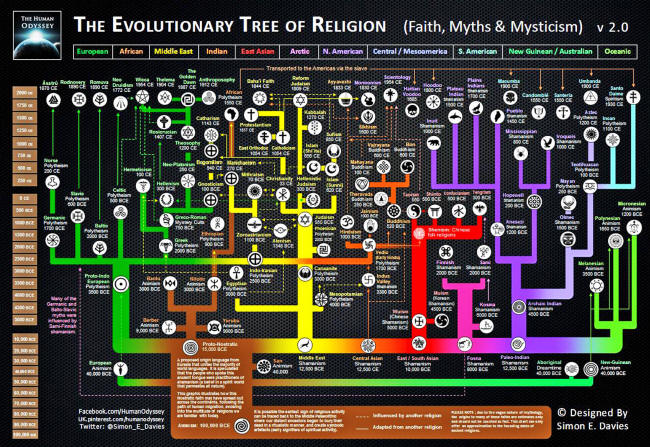|
It is plausible that from
such questions, our first primitive religions were formed.
This emerging faith was
the root belief system that would evolve and branch out into
numerous other ideologies all over the world. The journey of
these evolving religions can be
broken down into three classic periods.
Religions change over
time, they go extinct, and they split into distinct traditions...
The Evolutionary Tree Of Religion
These spirit entities
were believed to have powers and temperaments that influenced our
everyday world. By worshiping these divine beings, it was believed
we could maintain harmony with this spirit world and gain favors
from them.
Linguists and historians have defined a hypothetical language family called Nostratic, which seems to have influenced all the African and Eurasian dialects.
Many of the words that can be reconstructed involve nature gods (such as mother earth and father sky).
This suggests that the nature spirits of animism had evolved into a new generation of Gods (giving abstract beings of thunder and water a more human form).
During the Neolithic revolution, civilizations began to emerge requiring new areas of expertise (e.g. lawmaking, metallurgy, agriculture, and commerce).
It was the descendants of
the Nostratic Gods (e.g. the Indo-Europeans and
Sumerians) who took on the role of
guide and leader to the civilized world.
Man could either worship
one or all of these beings, gaining favor from them via offerings,
prayer and even sacrifice.
This system is known as Monotheism - a belief in one Supreme Being.
In 1348 BCE, the pharaoh Akhenaten, raised a lesser known God called 'Aten' to supreme status, downplaying the role of all other Egyptian deities.
A little later in Iran, Zoroaster (a Persian priest) claimed 'Ahura Mazda' to be the one supreme deity.
This newly emerging system posited that one creator god had formed the known universe, and was totally self-sufficient, capable of ruling over all other domains.
This idea became prominent in,
Most monotheistic systems tend to be exclusive in nature, which meant the gods of the Old World had to be purged from man's consciousness.
As a consequence, monotheistic religions displayed less religious tolerance than polytheistic religions, resulting in many wars and political disputes.
|



